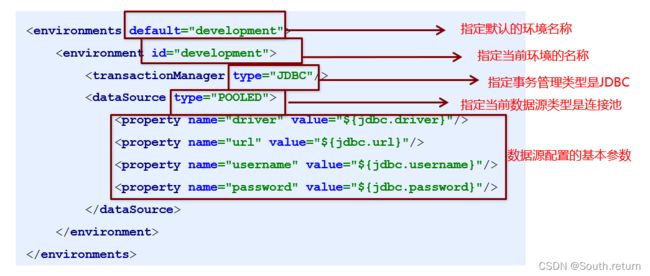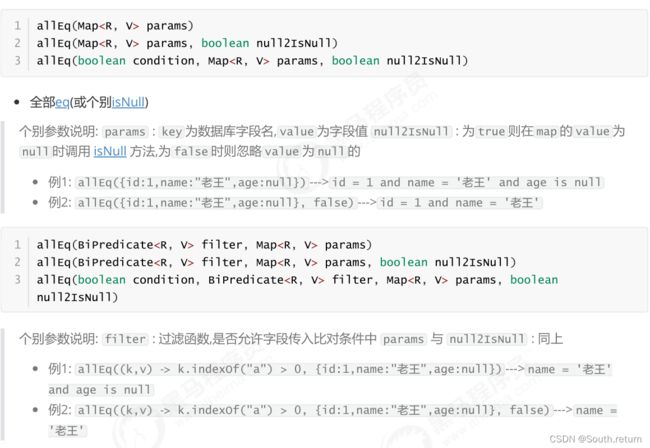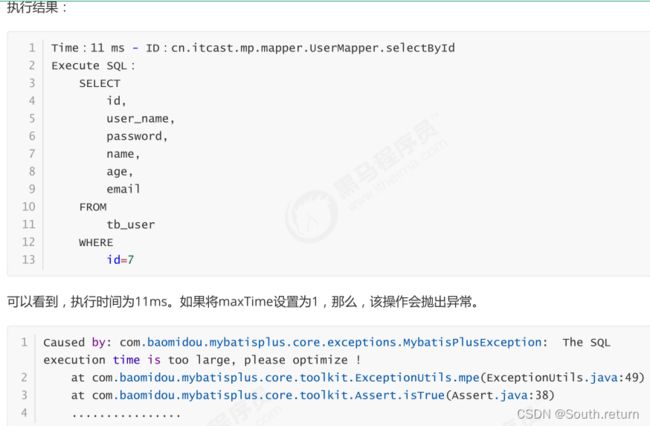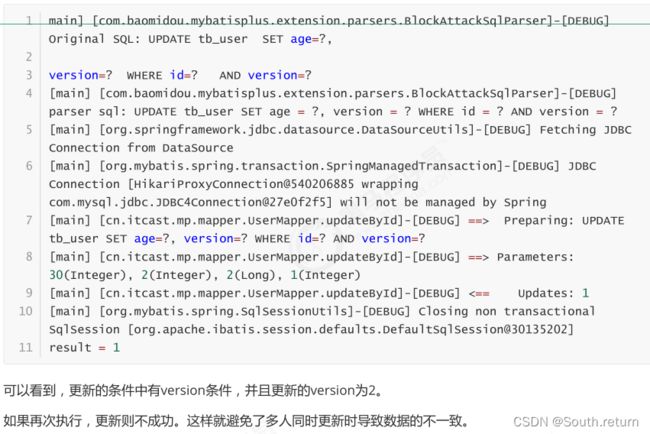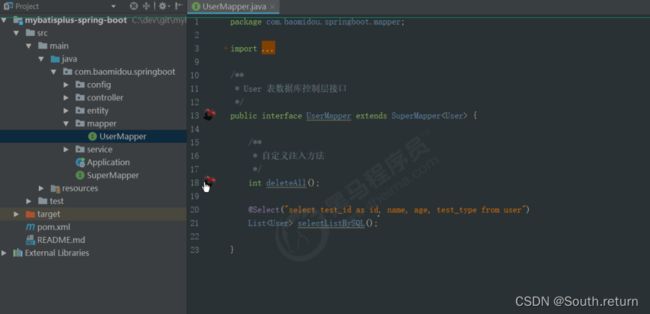MyBatis、MyBatis-plus
文章目录
- MyBatis
-
- 一、MyBatis简介
-
- 1. 什么是MyBatis
- 2. MyBatis开发步骤
- 3. 环境搭建
- 4. MyBatis的映射文件(UserMapper)
- 5. 动态sql语句
- 6. MyBatis的增删改查
- 二、MyBatis核心配置文件(sqlMapConfig)
-
- 1. MyBatis常用配置
-
- 1)environments标签
- 2)mapper标签
- 3)Properties标签
- 4)typeAliases标签
- 5)typeHandlers标签
- 6)plugins标签
- 2. 配置文件样例
- 三、MyBatis相应API
-
- 1. SqlSession工厂构建器SqlSessionFactoryBuilder
- 2. SqlSession工厂对象SqlSessionFactory
- 3. SqlSession会话对象
- 四、Mybatis的Dao层实现
- 五、MyBatis多表查询
-
- 实体类
-
- 1. 一对一查询
- 2. 一对多查询
- 3. 多对多查询
- 4. 知识小结
- 六、MyBatis的注解开发
-
- 1. MyBatis的常用注解
- 2. MyBatis的注解复杂映射开发
-
- 2.1 一对一查询
- 2.2 一对多查询
- 2.2 多对多查询
- MyBatis-Plus
-
-
- 1. Mybatis-Plus特性
- 2. Spring + Mybatis + MP
- 3. SpringBoot + Mybatis + MP
- 一、通用CRUD
-
- 1. 插入操作
- 2. 更新操作
-
- 2.1 updateById
- 2.2 根据条件更新
- 3. 删除操作
-
- 3.1 deleteById
- 3.2 deleteByMap
- 3.3 delete
- 3.4 deleteBatchIds
- 4. 查询操作
-
- 4.1 selectById
- 4.2 selectBatchIds
- 4.3 selectOne
- 4.4 selectCount
- 4.5 selectList
- 4.6 selectPage
- 二、基本配置
-
- 1. configLocation
- 2. mapperLocations
- 3. typeAliasesPackage
- 三、进阶配置
-
- 1. mapUnderscoreToCamelCase
- 2. cacheEnabled
- 3. idType
- 4. tablePrefix
- 四、条件构造器
-
- 1. allEq
- 2. 基于比较操作
- 3. 模糊查询
- 4. 排序
- 5. 逻辑查询
- 6. select
- 五、ActiveRecord
-
- 1. 新增数据
- 2. 更新操作
- 3. 删除操作
- 4. 根据主键查询
- 5. 根据条件查询
- 六、插件
-
- 1. mybatis的插件机制
- 2. 执行分析插件
- 3. 性能分析插件
- 4. 乐观锁插件
- 5. Sql注入器
- 6. 自动填充功能
- 7. 逻辑删除
- 8. 通用枚举
- 9. 代码生成器
- 10. MybatisX 快速开发插件
-
MyBatis
一、MyBatis简介
1. 什么是MyBatis
- mybatis 是一个优秀的基于java的持久层框架,它内部封装了jdbc,使开发者只需要关注sql语句本身,而不需要花费精力去处理加载驱动、创建连接、创建statement等繁杂的过程。
- mybatis通过xml或注解的方式将要执行的各种 statement配置起来,并通过java对象和statement中sql的动态参数进行映射生成最终执行的sql语句。
- 最后mybatis框架执行sql并将结果映射为java对象并返回。采用ORM思想解决了实体和数据库映射的问题,对jdbc 进行了封装,屏蔽了jdbc api 底层访问细节,使我们不用与jdbc api 打交道,就可以完成对数据库的持久化操作。
- 官网:https://mybatis.org/mybatis-3/
2. MyBatis开发步骤
①添加MyBatis的坐标
②创建user数据表
③编写User实体类
④编写映射文件UserMapper.xml
⑤编写核心文件SqlMapConfig.xml
⑥编写测试类
3. 环境搭建
1)导入MyBatis的坐标和其他相关坐标
<dependency>
<groupId>org.mybatisgroupId>
<artifactId>mybatisartifactId>
<version>3.4.5version>
dependency>
<dependency>
<groupId>mysqlgroupId>
<artifactId>mysql-connector-javaartifactId>
<version>5.1.6version>
<scope>runtimescope>
dependency>
<dependency>
<groupId>junitgroupId>
<artifactId>junitartifactId>
<version>4.12version>
<scope>testscope>
dependency>
<dependency>
<groupId>log4jgroupId>
<artifactId>log4jartifactId>
<version>1.2.12version>
dependency>
2)创建user数据表
3)编写User实体
public class User {
private int id;
private String username;
private String password;
//省略get个set方法
}
4)编写UserMapper映射文件
DOCTYPE mapper
PUBLIC "-//mybatis.org//DTD Mapper 3.0//EN"
"http://mybatis.org/dtd/mybatis-3-mapper.dtd">
<mapper namespace="userMapper">
<select id="findAll" resultType="com.itheima.domain.User">
select * from User
select>
mapper>
5)编写MyBatis核心文件
<configuration>
<environments default="development">
<environment id="development">
<transactionManager type="JDBC"/>
<dataSource type="POOLED">
<property name="driver" value="com.mysql.jdbc.Driver"/>
<property name="url" value="jdbc:mysql:///test"/>
<property name="username" value="root"/>
<property name="password" value="root"/>
dataSource>
environment>
environments>
<mappers>
<mapper resource="com/itheima/mapper/UserMapper.xml"/>
mappers>
configuration>
6)编写测试代码
//加载核心配置文件
InputStream resourceAsStream = Resources.getResourceAsStream("SqlMapConfig.xml");
//获得sqlSession工厂对象
SqlSessionFactory sqlSessionFactory = new
SqlSessionFactoryBuilder().build(resourceAsStream);
//获得sqlSession对象
SqlSession sqlSession = sqlSessionFactory.openSession();
//执行sql语句
List<User> userList = sqlSession.selectList("userMapper.findAll");
//打印结果
System.out.println(userList);
//释放资源
sqlSession.close();
4. MyBatis的映射文件(UserMapper)
5. 动态sql语句
5.1 动态 SQL
根据实体类的不同取值,使用不同的 SQL语句来进行查询。比如在 id如果不为空时可以根据id查询,如果username 不同空时还要加入用户名作为条件。
<select id="findByCondition" parameterType="user" resultType="user">
select * from User
<where>
<if test="id!=0">
and id=#{id}
if>
<if test="username!=null">
and username=#{username}
if>
where>
select>
5.2 动态 SQL
循环执行 sql 的拼接操作,例如:SELECT * FROM USER WHERE id IN (1,2,5)。
<select id="findByIds" parameterType="list" resultType="user">
select * from User
<where>
<foreach collection="array" open="id in(" close=")" item="id" separator=",">
#{id}
foreach>
where>
select>
•collection:代表要遍历的集合元素,注意编写时不要写#{}
•open:代表语句的开始部分
•close:代表结束部分
•item:代表遍历集合的每个元素,生成的变量名
•sperator:代表分隔符
5.3 SQL片段抽取
Sql 中可将重复的 sql 提取出来,使用时用 include 引用即可,最终达到 sql 重用的目的
<sql id="selectUser">select * from Usersql>
<select id="findById" parameterType="int" resultType="user">
<include refid="selectUser">include> where id=#{id}
select>
<select id="findByIds" parameterType="list" resultType="user">
<include refid="selectUser">include>
<where>
<foreach collection="array" open="id in(" close=")" item="id" separator=",">
#{id}
foreach>
where>
select>
6. MyBatis的增删改查
1. 插入操作注意问题
-
插入语句使用insert标签
-
在映射文件中使用parameterType属性指定要插入的数据类型
-
Sql语句中使用#{实体属性名}方式引用实体中的属性值
-
插入操作使用的API是sqlSession.insert(“命名空间.id”,实体对象);
-
插入操作涉及数据库数据变化,所以要使用sqlSession对象显示的提交事务,即sqlSession.commit()
2. 修改操作注意问题
-
修改语句使用update标签
-
修改操作使用的API是sqlSession.update(“命名空间.id”,实体对象);
3. 删除操作注意问题
-
删除语句使用delete标签
-
Sql语句中使用#{任意字符串}方式引用传递的单个参数
-
删除操作使用的API是sqlSession.delete(“命名空间.id”,Object);
二、MyBatis核心配置文件(sqlMapConfig)
1. MyBatis常用配置
1)environments标签
数据库环境的配置,支持多环境配置
事务管理器(transactionManager)类型有两种:
-
JDBC:这个配置就是直接使用了JDBC 的提交和回滚设置,它依赖于从数据源得到的连接来管理事务作用域。
-
MANAGED:这个配置几乎没做什么。它从来不提交或回滚一个连接,而是让容器来管理事务的整个生命周期(比如 JEE 应用服务器的上下文)。 默认情况下它会关闭连接,然而一些容器并不希望这样,因此需要将 closeConnection 属性设置为 false 来阻止它默认的关闭行为。
数据源(dataSource)类型有三种:
-
UNPOOLED:这个数据源的实现只是每次被请求时打开和关闭连接。
-
POOLED:这种数据源的实现利用“池”的概念将 JDBC 连接对象组织起来。
-
JNDI:这个数据源的实现是为了能在如 EJB 或应用服务器这类容器中使用,容器可以集中或在外部配置数据源,然后放置一个 JNDI 上下文的引用。
2)mapper标签
该标签的作用是加载映射配置
使用相对于类路径的资源引用,例如:
<mapper resource="org/mybatis/builder/AuthorMapper.xml"/>
使用完全限定资源定位符 (URL),例如:
<mapper url="file:///var/mappers/AuthorMapper.xml"/>
使用映射器接口实现类的完全限定类名,例如:
<mapper class="org.mybatis.builder.AuthorMapper"/>
将包内的映射器接口实现全部注册为映射器,例如:
<package name="org.mybatis.builder"/>
3)Properties标签
实际开发中,会将数据源的配置信息单独抽取成一个properties文件,可以加载额外配置的properties文件
4)typeAliases标签
概述:设置类型别名
类型别名是为 Java 类型设置一个短的名字。原来的类型名称配置如下
配置typeAliases,为com.itheima.domain.User定义别名为user
上面我们是自定义的别名,mybatis框架已经为我们设置好的一些常用的类型的别名
5)typeHandlers标签
无论是 MyBatis 在预处理语句(PreparedStatement)中设置一个参数时,还是从结果集中取出一个值时, 都会用类型处理器将获取的值以合适的方式转换成 Java 类型。下表描述了一些默认的类型处理器(截取部分)
你可以重写类型处理器或创建你自己的类型处理器来处理不支持的或非标准的类型。具体做法为:实现 org.apache.ibatis.type.TypeHandler 接口, 或继承一个很便利的类 org.apache.ibatis.type.BaseTypeHandler, 然后可以选择性地将它映射到一个JDBC类型。
例如需求:一个Java中的Date数据类型,我想将之存到数据库的时候存成一个1970年至今的毫秒数,取出来时转换成java的Date,即java的Date与数据库的varchar毫秒值之间转换。
开发步骤:
①定义转换类继承类BaseTypeHandler
②覆盖4个未实现的方法,其中setNonNullParameter为java程序设置数据到数据库的回调方法,getNullableResult为查询时 mysql的字符串类型转换成 java的Type类型的方法
③在MyBatis核心配置文件中进行注册
④测试转换是否正确
创建DateTypeHandler类
public class DateTypeHandler extends BaseTypeHandler<Date> {
//将java类型 转换成 数据库需要的类型
@Override
public void setNonNullParameter(PreparedStatement preparedStatement, int i, Date date, JdbcType jdbcType) throws SQLException {
long time = date.getTime();
preparedStatement.setLong(i, time);
}
//将数据库中类型 转换成java类型
//String参数 要转换的字段名称
//ResultSet 查询出的结果集
@Override
public Date getNullableResult(ResultSet resultSet, String s) throws SQLException {
//获得结果集中需要的数据(long) 转换成Date类型 返回
long aLong = resultSet.getLong(s);
return new Date(aLong);
}
//将数据库中类型 转换成java类型
@Override
public Date getNullableResult(ResultSet resultSet, int i) throws SQLException {
long aLong = resultSet.getLong(i);
return new Date(aLong);
}
//将数据库中类型 转换成java类型
@Override
public Date getNullableResult(CallableStatement callableStatement, int i) throws SQLException {
long aLong = callableStatement.getLong(i);
return new Date(aLong);
}
}
<typeHandlers>
<typeHandler handler="com.itheima.typeHandlers.MyDateTypeHandler">typeHandler>
typeHandlers>
6)plugins标签
MyBatis可以使用第三方的插件来对功能进行扩展,分页助手PageHelper是将分页的复杂操作进行封装,使用简单的方式即可获得分页的相关数据
开发步骤:
①导入通用PageHelper坐标
<dependency>
<groupId>com.github.pagehelpergroupId>
<artifactId>pagehelperartifactId>
<version>3.7.5version>
dependency>
<dependency>
<groupId>com.github.jsqlparsergroupId>
<artifactId>jsqlparserartifactId>
<version>0.9.1version>
dependency>
②在mybatis核心配置文件中配置PageHelper插件
<plugin interceptor="com.github.pagehelper.PageHelper">
<property name="dialect" value="mysql"/>
plugin>
③测试分页代码实现
@Test
public void testPageHelper(){
//设置分页参数
PageHelper.startPage(1,2);
List<User> select = userMapper2.select(null);
for(User user : select){
System.out.println(user);
}
}
获得分页相关的其他参数
//其他分页的数据
PageInfo<User> pageInfo = new PageInfo<User>(select);
System.out.println("总条数:"+pageInfo.getTotal());
System.out.println("总页数:"+pageInfo.getPages());
System.out.println("当前页:"+pageInfo.getPageNum());
System.out.println("每页显示长度:"+pageInfo.getPageSize());
System.out.println("是否第一页:"+pageInfo.isIsFirstPage());
System.out.println("是否最后一页:"+pageInfo.isIsLastPage());
分页样例
try {
//设置分页的相关参数: 当前页 每页显示的条数
PageHelper.startPage(currentPage, number);
List<T> list = carMapper.findList();
//获得与分页相关参数
PageInfo<T> pageInfo = new PageInfo<>(list);
//创建分页对象
PageBean<T> pageBean = new PageBean<>();
//设置总记录数
pageBean.setTotalCount((int) pageInfo.getTotal());
//设置总页数
pageBean.setTotalPage(pageInfo.getPages());
//当前页码
pageBean.setCurrentPage(pageInfo.getPageNum());
//对象集合
pageBean.setList(list);
return pageBean;
} catch (Exception e) {
e.printStackTrace();
return null;
}
2. 配置文件样例
DOCTYPE configuration PUBLIC "-//mybatis.org//DTD Config 3.0//EN" "http://mybatis.org/dtd/mybatis-3-config.dtd">
<configuration>
<properties resource="jdbc.properties">properties>
<typeAliases>
<typeAlias type="com.itheima.domain.User" alias="user">typeAlias>
typeAliases>
<typeHandlers>
<typeHandler handler="com.itheima.handler.DateTypeHandler">typeHandler>
typeHandlers>
<environments default="development">
<environment id="development">
<transactionManager type="JDBC">transactionManager>
<dataSource type="POOLED">
<property name="driver" value="${jdbc.driver}"/>
<property name="url" value="${jdbc.url}"/>
<property name="username" value="${jdbc.username}"/>
<property name="password" value="${jdbc.password}"/>
dataSource>
environment>
environments>
<mappers>
<package name="com.itheima.mapper"/>
mappers>
configuration>
三、MyBatis相应API
1. SqlSession工厂构建器SqlSessionFactoryBuilder
常用API:SqlSessionFactory build(InputStream inputStream)
通过加载mybatis的核心文件的输入流的形式构建一个SqlSessionFactory对象
String resource = "org/mybatis/builder/mybatis-config.xml";
InputStream inputStream = Resources.getResourceAsStream(resource);
SqlSessionFactoryBuilder builder = new SqlSessionFactoryBuilder();
SqlSessionFactory factory = builder.build(inputStream);
其中, Resources 工具类,这个类在 org.apache.ibatis.io 包中。Resources 类帮助你从类路径下、文件系统或一个 web URL 中加载资源文件。
2. SqlSession工厂对象SqlSessionFactory
SqlSessionFactory 有多个个方法创建SqlSession 实例。常用的有如下两个:
3. SqlSession会话对象
SqlSession 实例在 MyBatis 中是非常强大的一个类。在这里你会看到所有执行语句、提交或回滚事务和获取映射器实例的方法。
执行语句的方法主要有:
<T> T selectOne(String statement, Object parameter)
<E> List<E> selectList(String statement, Object parameter)
int insert(String statement, Object parameter)
int update(String statement, Object parameter)
int delete(String statement, Object parameter)
操作事务的方法主要有:
void commit()
void rollback()
四、Mybatis的Dao层实现
Mapper 接口开发方法只需要程序员编写Mapper 接口(相当于Dao 接口),由Mybatis 框架根据接口定义创建接口的动态代理对象,代理对象的方法体同上边Dao接口实现类方法。
Mapper 接口开发需要遵循以下规范:
-
Mapper.xml文件中的namespace与mapper接口的全限定名相同
-
Mapper接口方法名和Mapper.xml中定义的每个statement的id相同
-
Mapper接口方法的输入参数类型和mapper.xml中定义的每个sql的parameterType的类型相同
-
Mapper接口方法的输出参数类型和mapper.xml中定义的每个sql的resultType的类型相同
五、MyBatis多表查询
实体类
//订单类
public class Order {
private int id;
private Date ordertime;
private double total;
//代表当前订单从属于哪一个客户
private User user;
}
//用户类
public class User {
private int id;
private String username;
private String password;
private Date birthday;
//代表当前用户具备哪些订单
private List<Order> orderList;
//代表当前用户具备哪些角色
private List<Role> roleList;
}
//角色类
public class Role {
private int id;
private String rolename;
}
1. 一对一查询
一对一查询的模型
用户表和订单表的关系为,一个用户有多个订单,一个订单只从属于一个用户
一对一查询的需求:查询一个订单,与此同时查询出该订单所属的用户
<mapper namespace="com.itheima.mapper.OrderMapper">
<resultMap id="orderMap" type="order">
<id column="oid" property="id">id>
<result column="ordertime" property="ordertime">result>
<result column="total" property="total">result>
<association property="user" javaType="user">
<id column="uid" property="id">id>
<result column="username" property="username">result>
<result column="password" property="password">result>
<result column="birthday" property="birthday">result>
association>
resultMap>
<select id="findAll" resultMap="orderMap">
SELECT *,o.`id` oid FROM orders o,USER u WHERE o.uid=u.`id`
select>
mapper>
2. 一对多查询
一对多查询的模型
用户表和订单表的关系为,一个用户有多个订单,一个订单只从属于一个用户
一对多查询的需求:查询一个用户,与此同时查询出该用户具有的订单
<mapper namespace="com.itheima.mapper.UserMapper">
<resultMap id="userMap" type="user">
<id column="uid" property="id">id>
<result column="username" property="username">result>
<result column="password" property="password">result>
<result column="birthday" property="birthday">result>
<collection property="orderList" ofType="order">
<id column="oid" property="id">id>
<result column="ordertime" property="ordertime">result>
<result column="total" property="total">result>
collection>
resultMap>
<select id="findAll" resultMap="userMap">
SELECT *,o.`id` oid FROM USER u,orders o WHERE u.`id`=o.`uid`
select>
mapper>
3. 多对多查询
多对多查询的模型
用户表和角色表的关系为,一个用户有多个角色,一个角色被多个用户使用
多对多查询的需求:查询用户同时查询出该用户的所有角色
<mapper namespace="com.itheima.mapper.UserMapper">
<resultMap id="userRoleMap" type="user">
<id column="userId" property="id">id>
<result column="username" property="username">result>
<result column="password" property="password">result>
<result column="birthday" property="birthday">result>
<collection property="roleList" ofType="role">
<id column="roleId" property="id">id>
<result column="roleName" property="roleName">result>
<result column="roleDesc" property="roleDesc">result>
collection>
resultMap>
<select id="findUserAndRoleAll" resultMap="userRoleMap">
SELECT * FROM USER u,user_role ur,role r WHERE u.`id`=ur.`user_id` AND ur.`role_id`=r.`id`
select>
mapper>
4. 知识小结
MyBatis多表配置方式
一对一配置:使用
一对多配置:使用
多对多配置:使用
六、MyBatis的注解开发
1. MyBatis的常用注解
MyBatis也可以使用注解开发方式,这样我们就可以减少编写Mapper映射文件了。
@Insert:实现新增
@Update:实现更新
@Delete:实现删除
@Select:实现查询
@Result:实现结果集封装
@Results:可以与@Result 一起使用,封装多个结果集
@One:实现一对一结果集封装
@Many:实现一对多结果集封装
修改MyBatis的核心配置文件,需要加载使用了注解的Mapper接口
<mappers>
<mapper class="com.itheima.mapper.UserMapper">mapper>
mappers>
或者指定扫描包含映射关系的接口所在的包
<mappers>
<package name="com.itheima.mapper">package>
mappers>
2. MyBatis的注解复杂映射开发
实现复杂关系映射之前我们可以在映射文件中通过配置来实现,使用注解开发后,可以使用@Results注解,@Result注解,@One注解,@Many注解组合完成复杂关系的配置
2.1 一对一查询
使用注解配置Mapper
public interface OrderMapper {
/* 第一种方式
@Select("select *,o.id oid from orders o,user u where o.uid=u.id")
@Results({
@Result(column = "oid", property = "id"),
@Result(column = "ordertime", property = "ordertime"),
@Result(column = "total", property = "total"),
@Result(column = "uid", property = "user.id"),
@Result(column = "username", property = "user.username"),
@Result(column = "password", property = "user.password")
})
List findAll();
*/
// 第二种方式
@Select("select * from orders")
@Results({
// id是否为主键
@Result(id=true,property = "id",column = "id"),
@Result(property = "ordertime",column = "ordertime"),
@Result(property = "total",column = "total"),
@Result(property = "user", // 要封装的属性名称
column = "uid", // 根据哪个字段查询user表的数据
javaType = User.class, // 要封装的实体类型
// select属性 代表查询哪个接口的方法获得数据
one = @One(select = "com.itheima.mapper.UserMapper.findById"))
})
List<Order> findAll();
}
public interface UserMapper {
@Select("select * from user where id=#{id}")
User findById(int id);
}
2.2 一对多查询
使用注解配置Mapper
public interface UserMapper {
@Select("select * from user")
@Results({
@Result(id = true,property = "id",column = "id"),
@Result(property = "username",column = "username"),
@Result(property = "password",column = "password"),
@Result(property = "birthday",column = "birthday"),
@Result(property = "orderList",
column = "id",
javaType = List.class,
many = @Many(select = "com.itheima.mapper.OrderMapper.findByUid"))
})
List<User> findAllUserAndOrder();
}
public interface OrderMapper {
@Select("select * from orders where uid=#{uid}")
List<Order> findByUid(int uid);
}
2.2 多对多查询
使用注解配置Mapper
public interface UserMapper {
@Select("select * from user")
@Results({
@Result(id = true,property = "id",column = "id"),
@Result(property = "username",column = "username"),
@Result(property = "password",column = "password"),
@Result(property = "birthday",column = "birthday"),
@Result(property = "roleList",
column = "id",
javaType = List.class,
many = @Many(select = "com.itheima.mapper.RoleMapper.findByUid"))
})
List<User> findAllUserAndRole();
}
public interface RoleMapper {
@Select("select * from role r,user_role ur where r.id=ur.role_id and ur.user_id=#{uid}")
List<Role> findByUid(int uid);
}
MyBatis-Plus
1. Mybatis-Plus特性
- 无侵入:只做增强不做改变,引入它不会对现有工程产生影响,如丝般顺滑
- 损耗小:启动即会自动注入基本 CURD,性能基本无损耗,直接面向对象操作
- 强大的 CRUD 操作:内置通用 Mapper、通用 Service,仅仅通过少量配置即可实现单表大部分 CRUD 操作,更有强大的条件构造器,满足各类使用需求
- 支持 Lambda 形式调用:通过 Lambda 表达式,方便的编写各类查询条件,无需再担心字段写错
- 支持多种数据库:支持 MySQL、MariaDB、Oracle、DB2、H2、HSQL、SQLite、Postgre、SQLServer2005、SQLServer 等多种数据库
- 支持主键自动生成:支持多达 4 种主键策略(内含分布式唯一 ID 生成器 - Sequence),可自由配置,完美解决主键问题
- 支持 XML 热加载:Mapper 对应的 XML 支持热加载,对于简单的 CRUD 操作,甚至可以无 XML 启动
- 支持 ActiveRecord 模式:支持 ActiveRecord 形式调用,实体类只需继承 Model 类即可进行 CRUD操作
- 支持自定义全局通用操作:支持全局通用方法注入( Write once, use anywhere )
- 支持关键词自动转义:支持数据库关键词(order、key…)自动转义,还可自定义关键词
- 内置代码生成器:采用代码或者 Maven 插件可快速生成 Mapper 、 Model 、 Service 、 Controller 层代码,支持模板引擎,更有超多自定义配置等您来使用
- 内置分页插件:基于 MyBatis 物理分页,开发者无需关心具体操作,配置好插件之后,写分页等同于普通 List查询
- 内置性能分析插件:可输出 Sql 语句以及其执行时间,建议开发测试时启用该功能,能快速揪出慢查询
- 内置全局拦截插件:提供全表 delete 、 update 操作智能分析阻断,也可自定义拦截规则,预防误操作
- 内置 Sql 注入剥离器:支持 Sql 注入剥离,有效预防 Sql 注入攻击
- 官网:https://baomidou.com/pages/24112f/
2. Spring + Mybatis + MP
2.1 导入依赖
<dependency>
<groupId>com.baomidougroupId>
<artifactId>mybatis-plusartifactId>
<version>3.1.1version>
dependency>
<dependency>
<groupId>mysqlgroupId>
<artifactId>mysql-connector-javaartifactId>
<version>5.1.47version>
dependency>
<dependency>
<groupId>com.alibabagroupId>
<artifactId>druidartifactId>
<version>1.0.11version>
dependency>
<dependency>
<groupId>org.projectlombokgroupId>
<artifactId>lombokartifactId>
<optional>trueoptional>
<version>1.18.4version>
dependency>
<dependency>
<groupId>junitgroupId>
<artifactId>junitartifactId>
<version>4.12version>
dependency>
<dependency>
<groupId>org.slf4jgroupId>
<artifactId>slf4j-log4j12artifactId>
<version>1.6.4version>
dependency>
<dependency>
<groupId>org.springframeworkgroupId>
<artifactId>spring-webmvcartifactId>
<version>${spring.version}version>
dependency>
<dependency>
<groupId>org.springframeworkgroupId>
<artifactId>spring-jdbcartifactId>
<version>${spring.version}version>
dependency>
<dependency>
<groupId>org.springframeworkgroupId>
<artifactId>spring-testartifactId>
<version>${spring.version}version>
dependency>
2.2 编写jdbc.properties
jdbc.driver=com.mysql.jdbc.Driver
jdbc.url=jdbc:mysql://127.0.0.1:3306/test?useUnicode=true&characterEncoding=utf8&autoReconnect=true&allowMultiQueries=true&useSSL=false
jdbc.username=root
jdbc.password=root
2.3 编写applicationContext.xml
<beans xmlns="http://www.springframework.org/schema/beans"
xmlns:xsi="http://www.w3.org/2001/XMLSchema-instance"
xmlns:context="http://www.springframework.org/schema/context"
xsi:schemaLocation="http://www.springframework.org/schema/beans
http://www.springframework.org/schema/beans/spring-beans.xsd
http://www.springframework.org/schema/context
http://www.springframework.org/schema/context/spring-context.xsd">
<context:property-placeholder location="classpath:*.properties"/>
<bean id="dataSource" class="com.alibaba.druid.pool.DruidDataSource" destroy-method="close">
<property name="url" value="${jdbc.url}"/>
<property name="username" value="${jdbc.username}"/>
<property name="password" value="${jdbc.password}"/>
<property name="driverClassName" value="${jdbc.driver}"/>
<property name="maxActive" value="10"/>
<property name="minIdle" value="5"/>
bean>
<bean id="sqlSessionFactory" class="com.baomidou.mybatisplus.extension.spring.MybatisSqlSessionFactoryBean">
<property name="dataSource" ref="dataSource"/>
bean>
<bean class="org.mybatis.spring.mapper.MapperScannerConfigurer">
<property name="basePackage" value="cn.itcast.mp.simple.mapper"/>
bean>
beans>
2.4 编写User对象以及UserMapper接口
@Data //可以省去代码中大量的get()、 set()、 toString()等方法
@NoArgsConstructor // 生成一个无参数的构造方法
@AllArgsConstructor //生成一个包含所有变量的构造方法
@TableName("tb_user") //指定的数据库表和 JavaBean 进行映射
public class User {
private Long id;
private String userName;
private String password;
private String name;
private Integer age;
private String email;
}
public interface UserMapper extends BaseMapper<User> {
}
2.5 编写测试用例
@RunWith(SpringJUnit4ClassRunner.class)
@ContextConfiguration(locations = "classpath:applicationContext.xml")
public class TestSpringMP {
@Autowired
private UserMapper userMapper;
@Test
public void testSelectList() {
List<User> users = this.userMapper.selectList(null);
for (User user : users) {
System.out.println(user);
}
}
}
3. SpringBoot + Mybatis + MP
3.1 导入依赖
<parent>
<groupId>org.springframework.bootgroupId>
<artifactId>spring-boot-starter-parentartifactId>
<version>2.1.4.RELEASEversion>
parent>
<groupId>cn.itcast.mpgroupId>
<artifactId>itcast-mp-springbootartifactId>
<version>1.0-SNAPSHOTversion>
<dependency>
<groupId>org.springframework.bootgroupId>
<artifactId>spring-boot-starterartifactId>
<exclusions>
<exclusion>
<groupId>org.springframework.bootgroupId>
<artifactId>spring-boot-starter-loggingartifactId>
exclusion>
exclusions>
dependency>
<dependency>
<groupId>org.springframework.bootgroupId>
<artifactId>spring-boot-starter-testartifactId>
<scope>testscope>
dependency>
<dependency>
<groupId>org.projectlombokgroupId>
<artifactId>lombokartifactId>
<optional>trueoptional>
dependency>
<dependency>
<groupId>com.baomidougroupId>
<artifactId>mybatis-plus-boot-starterartifactId>
<version>3.1.1version>
dependency>
<dependency>
<groupId>mysqlgroupId>
<artifactId>mysql-connector-javaartifactId>
<version>5.1.47version>
dependency>
<dependency>
<groupId>org.slf4jgroupId>
<artifactId>slf4j-log4j12artifactId>
dependency>
3.2 编写application.properties
spring.application.name = itcast-mp-springboot
spring.datasource.driver-class-name=com.mysql.jdbc.Driver
spring.datasource.url=jdbc:mysql://127.0.0.1:3306/mp?useUnicode=true&characterEncoding=utf8&autoReconnect=true&allowMultiQueries=true&useSSL=false
spring.datasource.username=root
spring.datasource.password=root
3.3 编写domain
@Data
@NoArgsConstructor
@AllArgsConstructor
@TableName("tb_user")
public class User {
private Long id;
private String userName;
private String password;
private String name;
private Integer age;
private String email;
}
3.4 编写mapper
public interface UserMapper extends BaseMapper<User> {
}
3.5 编写启动类
@MapperScan("cn.itcast.mp.mapper") //设置mapper接口的扫描包
@SpringBootApplication
public class MyApplication {
public static void main(String[] args) {
SpringApplication.run(MyApplication.class, args);
}
}
3.6 编写测试用例
@RunWith(SpringJUnit4ClassRunner.class)
@SpringBootTest
public class TestMybatisSpringBoot {
@Autowired
private UserMapper userMapper;
@Test
public void testSelectList(){
List<User> users = this.userMapper.selectList(null);
for (User user : users) {
System.out.println(user);
}
}
}
一、通用CRUD
1. 插入操作
/**
* 插入一条记录
*
* @param entity 实体对象
*/
int insert(T entity);
@Test
public void testInsert(){
User user = new User();
user.setAge(20);
user.setEmail("test@itcast.cn");
user.setName("曹操");
user.setUserName("caocao");
user.setPassword("123456");
int result = this.userMapper.insert(user); //返回的result是受影响的行数
System.out.println("result = " + result);
System.out.println(user.getId()); //自增后的id会回填到对象中
}
数据已经写入到了数据库,但是id的值不正确,我们期望的是数据库自增长,实际是MP生成了id的值写入到了数据库。如何设置id的生成策略呢?MP支持的id策略:
/**
* 生成ID类型枚举类
*
* @author hubin
* @since 2015-11-10
*/
@Getter
public enum IdType {
/**
* 数据库ID自增
*/
AUTO(0),
/**
* 该类型为未设置主键类型
*/
NONE(1),
/**
* 用户输入ID
* 该类型可以通过自己注册自动填充插件进行填充
*/
INPUT(2),
/* 以下3种类型、只有当插入对象ID 为空,才自动填充。 */
/**
* 全局唯一ID (idWorker)
*/
ID_WORKER(3),
/**
* 全局唯一ID (UUID)
*/
UUID(4),
/**
* 字符串全局唯一ID (idWorker 的字符串表示)
*/
ID_WORKER_STR(5);
private final int key;
IdType(int key) {
this.key = key;
}
}
在MP中通过@TableField注解可以指定字段的一些属性,常常解决的问题有2个:
- 对象中的属性名和字段名不一致的问题(非驼峰)
- 对象中的属性字段在表中不存在的问题
@Data
@NoArgsConstructor
@AllArgsConstructor
@TableName("tb_user")
public class User extends Model<User> {
@TableId(type = IdType.AUTO) //指定id类型为自增长
private Long id;
private String userName;
@TableField(select = false) //查询时不返回该字段的值
private String password;
private String name;
private Integer age;
@TableField(value = "email") //指定数据表中字段名
private String mail;
@TableField(exist = false)
private String address; //在数据库表中是不存在的
}
2. 更新操作
2.1 updateById
/**
* 根据 ID 修改
*
* @param entity 实体对象
*/
int updateById(@Param(Constants.ENTITY) T entity);
@Test
public void testUpdateById() {
User user = new User();
user.setId(6L); //主键
user.setAge(21); //更新的字段
//根据id更新,更新不为null的字段
this.userMapper.updateById(user);
}
2.2 根据条件更新
/**
* 根据 whereEntity 条件,更新记录
*
* @param entity 实体对象 (set 条件值,可以为 null)
* @param updateWrapper 实体对象封装操作类(可以为 null,里面的 entity 用于生成 where 语句)
*/
int update(@Param(Constants.ENTITY) T entity, @Param(Constants.WRAPPER) Wrapper<T>
updateWrapper);
@Test
public void testUpdate() {
User user = new User();
user.setAge(22); //更新的字段
//更新的条件
QueryWrapper<User> wrapper = new QueryWrapper<>();
wrapper.eq("id", 6);
//执行更新操作
int result = this.userMapper.update(user, wrapper);
System.out.println("result = " + result);
}
@Test
public void testUpdate() {
//更新的条件以及字段
UpdateWrapper<User> wrapper = new UpdateWrapper<>();
wrapper.eq("id", 6).set("age", 23);
//执行更新操作
int result = this.userMapper.update(null, wrapper);
System.out.println("result = " + result);
}
3. 删除操作
3.1 deleteById
/**
* 根据 ID 删除
*
* @param id 主键ID
*/
int deleteById(Serializable id);
@Test
public void testDeleteById() {
//执行删除操作
int result = this.userMapper.deleteById(6L);
System.out.println("result = " + result);
}
3.2 deleteByMap
/**
* 根据 columnMap 条件,删除记录
*
* @param columnMap 表字段 map 对象
*/
int deleteByMap(@Param(Constants.COLUMN_MAP) Map<String, Object> columnMap);
@Test
public void testDeleteByMap() {
Map<String, Object> columnMap = new HashMap<>();
columnMap.put("age",20);
columnMap.put("name","张三");
//将columnMap中的元素设置为删除的条件,多个之间为and关系
int result = this.userMapper.deleteByMap(columnMap);
System.out.println("result = " + result);
}
3.3 delete
/**
* 根据 entity 条件,删除记录
*
* @param wrapper 实体对象封装操作类(可以为 null)
*/
int delete(@Param(Constants.WRAPPER) Wrapper<T> wrapper);
@Test
public void testDeleteByMap() {
User user = new User();
user.setAge(20);
user.setName("张三");
//将实体对象进行包装,包装为操作条件
QueryWrapper<User> wrapper = new QueryWrapper<>(user);
int result = this.userMapper.delete(wrapper);
System.out.println("result = " + result);
}
3.4 deleteBatchIds
/**
* 删除(根据ID 批量删除)
*
* @param idList 主键ID列表(不能为 null 以及 empty)
*/
int deleteBatchIds(@Param(Constants.COLLECTION) Collection<? extends Serializable>
idList);
@Test
public void testDeleteByMap() {
//根据id集合批量删除
int result = this.userMapper.deleteBatchIds(Arrays.asList(1L,10L,20L));
System.out.println("result = " + result);
}
4. 查询操作
4.1 selectById
/**
* 根据 ID 查询
*
* @param id 主键ID
*/
T selectById(Serializable id);
@Test
public void testSelectById() {
//根据id查询数据
User user = this.userMapper.selectById(2L);
System.out.println("result = " + user);
}
4.2 selectBatchIds
/**
* 查询(根据ID 批量查询)
*
* @param idList 主键ID列表(不能为 null 以及 empty)
*/
List<T> selectBatchIds(@Param(Constants.COLLECTION) Collection<? extends Serializable>
idList);
@Test
public void testSelectBatchIds() {
//根据id集合批量查询
List<User> users = this.userMapper.selectBatchIds(Arrays.asList(2L, 3L, 10L));
for (User user : users) {
System.out.println(user);
}
}
4.3 selectOne
/**
* 根据 entity 条件,查询一条记录
*
* @param queryWrapper 实体对象封装操作类(可以为 null)
*/
T selectOne(@Param(Constants.WRAPPER) Wrapper<T> queryWrapper);
@Test
public void testSelectOne() {
QueryWrapper<User> wrapper = new QueryWrapper<User>();
wrapper.eq("name", "李四");
//根据条件查询一条数据,如果结果超过一条会报错
User user = this.userMapper.selectOne(wrapper);
System.out.println(user);
}
4.4 selectCount
/**
* 根据 Wrapper 条件,查询总记录数
*
* @param queryWrapper 实体对象封装操作类(可以为 null)
*/
Integer selectCount(@Param(Constants.WRAPPER) Wrapper<T> queryWrapper);
@Test
public void testSelectCount() {
QueryWrapper<User> wrapper = new QueryWrapper<User>();
wrapper.gt("age", 23); //年龄大于23岁
//根据条件查询数据条数
Integer count = this.userMapper.selectCount(wrapper);
System.out.println("count = " + count);
}
4.5 selectList
/**
* 根据 entity 条件,查询全部记录
*
* @param queryWrapper 实体对象封装操作类(可以为 null)
*/
List<T> selectList(@Param(Constants.WRAPPER) Wrapper<T> queryWrapper);
@Test
public void testSelectList() {
QueryWrapper<User> wrapper = new QueryWrapper<User>();
wrapper.gt("age", 23); //年龄大于23岁
//根据条件查询数据
List<User> users = this.userMapper.selectList(wrapper);
for (User user : users) {
System.out.println("user = " + user);
}
}
4.6 selectPage
/**
* 根据 entity 条件,查询全部记录(并翻页)
*
* @param page 分页查询条件(可以为 RowBounds.DEFAULT)
* @param queryWrapper 实体对象封装操作类(可以为 null)
*/
IPage<T> selectPage(IPage<T> page, @Param(Constants.WRAPPER) Wrapper<T> queryWrapper);
配置分页插件
@Configuration
@MapperScan("cn.itcast.mp.mapper") //设置mapper接口的扫描包
public class MybatisPlusConfig {
/**
* 分页插件
*/
@Bean
public PaginationInterceptor paginationInterceptor() {
return new PaginationInterceptor();
}
}
@Test
public void testSelectPage() {
QueryWrapper<User> wrapper = new QueryWrapper<User>();
wrapper.gt("age", 20); //年龄大于20岁
Page<User> page = new Page<>(1,1); // 查询第一页,查询一条数据
//根据条件查询数据
IPage<User> iPage = this.userMapper.selectPage(page, wrapper);
System.out.println("数据总条数:" + iPage.getTotal());
System.out.println("总页数:" + iPage.getPages());
List<User> users = iPage.getRecords();
for (User user : users) {
System.out.println("user = " + user);
}
}
二、基本配置
1. configLocation
MyBatis 配置文件位置,如果您有单独的 MyBatis 配置,请将其路径配置到 configLocation 中。
Spring Boot
mybatis-plus.config-location = classpath:mybatis-config.xml
Spring MVC
<bean id="sqlSessionFactory"
class="com.baomidou.mybatisplus.extension.spring.MybatisSqlSessionFactoryBean">
<property name="configLocation" value="classpath:mybatis-config.xml"/>
bean>
2. mapperLocations
MyBatis Mapper 所对应的 XML 文件位置,如果您在 Mapper 中有自定义方法(XML 中有自定义实现),需要进行该配置,告诉 Mapper 所对应的 XML 文件位置。
Spring Boot
mybatis-plus.mapper-locations = classpath*:mybatis/*.xml
Spring MVC
<bean id="sqlSessionFactory"
class="com.baomidou.mybatisplus.extension.spring.MybatisSqlSessionFactoryBean">
<property name="mapperLocations" value="classpath*:mybatis/*.xml"/>
bean>
注意:Maven 多模块项目的扫描路径需以 classpath*: 开头 (即加载多个 jar 包下的 XML 文件)
3. typeAliasesPackage
MyBaits 别名包扫描路径,通过该属性可以给包中的类注册别名,注册后在 Mapper 对应的 XML 文件中可以直接使用类名,而不用使用全限定的类名(即 XML 中调用的时候不用包含包名)
Spring Boot
mybatis-plus.type-aliases-package = cn.itcast.mp.pojo
Spring MVC
<bean id="sqlSessionFactory"
class="com.baomidou.mybatisplus.extension.spring.MybatisSqlSessionFactoryBean">
<property name="typeAliasesPackage"
value="com.baomidou.mybatisplus.samples.quickstart.entity"/>
bean>
三、进阶配置
本部分(Configuration)的配置大都为 MyBatis 原生支持的配置,这意味着您可以通过 MyBatis XML 配置文件的形式进行配置。
1. mapUnderscoreToCamelCase
SpringBoot
# 关闭自动驼峰映射,该参数不能和mybatis-plus.config-location同时存在
mybatis-plus.configuration.map-underscore-to-camel-case=false
2. cacheEnabled
- 类型: boolean
- 默认值: true
全局地开启或关闭配置文件中的所有映射器已经配置的任何缓存,默认为 true
mybatis-plus.configuration.cache-enabled=false
3. idType
- 类型: com.baomidou.mybatisplus.annotation.IdType
- 默认值: ID_WORKER
全局默认主键类型,设置后,即可省略实体对象中的@TableId(type = IdType.AUTO)配置。
Spring Boot
mybatis-plus.global-config.db-config.id-type=auto
String MVC
<bean id="sqlSessionFactory" class="com.baomidou.mybatisplus.extension.spring.MybatisSqlSessionFactoryBean">
<property name="dataSource" ref="dataSource"/>
<property name="globalConfig">
<bean class="com.baomidou.mybatisplus.core.config.GlobalConfig">
<property name="dbConfig">
<bean class="com.baomidou.mybatisplus.core.config.GlobalConfig$DbConfig">
<property name="idType" value="AUTO"/>
bean>
property>
bean>
property>
bean>
4. tablePrefix
- 类型: String
- 默认值: null
表名前缀,全局配置后可省略@TableName()配置。
Spring Boot
mybatis-plus.global-config.db-config.table-prefix=tb_
String MVC
<bean id="sqlSessionFactory"
class="com.baomidou.mybatisplus.extension.spring.MybatisSqlSessionFactoryBean">
<property name="dataSource" ref="dataSource"/>
<property name="globalConfig">
<bean class="com.baomidou.mybatisplus.core.config.GlobalConfig">
<property name="dbConfig">
<bean class="com.baomidou.mybatisplus.core.config.GlobalConfig$DbConfig">
<property name="idType" value="AUTO"/>
<property name="tablePrefix" value="tb_"/>
bean>
property>
bean>
property>
bean>
四、条件构造器
在MP中,Wrapper接口的实现类关系如下:
说明:QueryWrapper(LambdaQueryWrapper) 和 UpdateWrapper(LambdaUpdateWrapper) 的父类用于生成 sql的 where 条件, entity 属性也用于生成 sql 的 where 条件。
注意:entity 生成的 where 条件与 使用各个 api 生成的 where 条件没有任何关联行为。
官网文档地址: https://mybatis.plus/guide/wrapper.html
1. allEq
@Test
public void testWrapper() {
QueryWrapper<User> wrapper = new QueryWrapper<>();
//设置条件
Map<String,Object> params = new HashMap<>();
params.put("name", "曹操");
params.put("age", "20");
params.put("password", null);
//SELECT * FROM tb_user WHERE password IS NULL AND name = ? AND age = ?
//wrapper.allEq(params);
//SELECT * FROM tb_user WHERE name = ? AND age= ?
//wrapper.allEq(params,false);
//SELECT * FROM tb_user WHERE name = ? AND age = ?
//wrapper.allEq((k, v) -> (k.equals("name") || k.equals("age")),params);
List<User> users = this.userMapper.selectList(wrapper);
for (User user : users) {
System.out.println(user);
}
}
2. 基于比较操作
eq 等于 =
ne 不等于 <>
gt 大于 >
ge 大于等于 >=
lt 小于 <
le 小于等于 <=
between BETWEEN 值1 AND 值2
notBetween NOT BETWEEN 值1 AND 值2
in 字段 IN (value.get(0), value.get(1), ...)
notIn 字段 NOT IN (v0, v1, ...)
@Test
public void testEq() {
QueryWrapper<User> wrapper = new QueryWrapper<>();
// SELECT id,user_name,password,name,age,email FROM tb_user WHERE password = ?
// AND age >= ? AND name IN (?,?,?)
wrapper.eq("password", "123456")
.ge("age", 20)
.in("name", "李四", "王五", "赵六");
List<User> users = this.userMapper.selectList(wrapper);
for (User user : users) {
System.out.println(user);
}
}
3. 模糊查询
like LIKE '%值%'
例: like("name", "王") ---> name like '%王%'
notLike NOT LIKE '%值%'
例: notLike("name", "王") ---> name not like '%王%'
likeLeft LIKE '%值'
例: likeLeft("name", "王") ---> name like '%王'
likeRight LIKE '值%'
例: likeRight("name", "王") ---> name like '王%'
@Test
public void testWrapper() {
QueryWrapper<User> wrapper = new QueryWrapper<>();
// SELECT id,user_name,password,name,age,email FROM tb_user WHERE name LIKE ?
// Parameters: %曹%(String)
wrapper.like("name", "曹");
List<User> users = this.userMapper.selectList(wrapper);
for (User user : users) {
System.out.println(user);
}
}
4. 排序
orderBy 排序:ORDER BY 字段, ...
例: orderBy(true, true, "id", "name") ---> order by id ASC,name ASC
orderByAsc 排序:ORDER BY 字段, ... ASC
例: orderByAsc("id", "name") ---> order by id ASC,name ASC
orderByDesc 排序:ORDER BY 字段, ... DESC
例: orderByDesc("id", "name") ---> order by id DESC,name DESC
@Test
public void testWrapper() {
QueryWrapper<User> wrapper = new QueryWrapper<>();
//SELECT id,user_name,password,name,age,email FROM tb_user ORDER BY age DESC
wrapper.orderByDesc("age");
List<User> users = this.userMapper.selectList(wrapper);
for (User user : users) {
System.out.println(user);
}
}
5. 逻辑查询
or 拼接 OR
主动调用 or 表示紧接着下一个方法不是用 and 连接!(不调用 or 则默认为使用 and 连接)
and AND 嵌套
例: and(i -> i.eq("name", "李白").ne("status", "活着"))
---> and (name = '李白' and status<> '活着')
@Test
public void testWrapper() {
QueryWrapper<User> wrapper = new QueryWrapper<>();
// SELECT id,user_name,password,name,age,email FROM tb_user WHERE name = ? OR
// age = ?
wrapper.eq("name","李四").or().eq("age", 24);
List<User> users = this.userMapper.selectList(wrapper);
for (User user : users) {
System.out.println(user);
}
}
6. select
在MP查询中,默认查询所有的字段,如果有需要也可以通过select方法进行指定字段。
@Test
public void testWrapper() {
QueryWrapper<User> wrapper = new QueryWrapper<>();
//SELECT id,name,age FROM tb_user WHERE name = ? OR age = ?
wrapper.eq("name", "李四")
.or()
.eq("age", 24)
.select("id", "name", "age");
List<User> users = this.userMapper.selectList(wrapper);
for (User user : users) {
System.out.println(user);
}
}
五、ActiveRecord
什么是ActiveRecord?
ActiveRecord也属于ORM(对象关系映射)层,由Rails最早提出,遵循标准的ORM模型:表映射到记录,记录映射到对象,字段映射到对象属性。配合遵循的命名和配置惯例,能够很大程度的快速实现模型的操作,简洁易懂。
ActiveRecord的主要思想是:
-
每一个数据库表对应创建一个类,类的每一个对象实例对应于数据库中表的一行记录;通常表的每个字段
在类中都有相应的Field -
ActiveRecord 同时负责把自己持久化,在ActiveRecord中封装了对数据库的访问,即CURD
-
ActiveRecord 是一种领域模型(Domain Model),封装了部分业务逻辑
在MP中,开启AR非常简单,只需要将实体对象继承Model即可。
@Data
@NoArgsConstructor
@AllArgsConstructor
public class User extends Model<User> {
private Long id;
private String userName;
private String password;
private String name;
private Integer age;
private String email;
}
1. 新增数据
@Test
public void testAR() {
User user = new User();
user.setName("刘备");
user.setAge(30);
user.setPassword("123456");
user.setUserName("liubei");
user.setEmail("liubei@itcast.cn");
boolean insert = user.insert();
System.out.println(insert);
}
2. 更新操作
@Test
public void testAR() {
User user = new User();
user.setId(8L);
user.setAge(35);
boolean update = user.updateById();
System.out.println(update);
}
3. 删除操作
@Test
public void testAR() {
User user = new User();
user.setId(7L);
boolean delete = user.deleteById();
System.out.println(delete);
}
4. 根据主键查询
@Test
public void testAR() {
User user = new User();
user.setId(2L);
User user2 = user.selectById();
System.out.println(user2);
}
5. 根据条件查询
@Test
public void testAR() {
User user = new User();
QueryWrapper<User> userQueryWrapper = new QueryWrapper<>();
userQueryWrapper.le("age","20");
List<User> users = user.selectList(userQueryWrapper);
for (User user1 : users) {
System.out.println(user1);
}
}
六、插件
1. mybatis的插件机制
@Intercepts({@Signature(
type= Executor.class,
method = "update",
args = {MappedStatement.class,Object.class})})
public class MyInterceptor implements Interceptor {
@Override
public Object intercept(Invocation invocation) throws Throwable {
//拦截方法,具体业务逻辑编写的位置
return invocation.proceed();
}
@Override
public Object plugin(Object target) {
//创建target对象的代理对象,目的是将当前拦截器加入到该对象中
return Plugin.wrap(target, this);
}
@Override
public void setProperties(Properties properties) {
//属性设置
}
}
2. 执行分析插件
在MP中提供了对SQL执行的分析的插件,可用作阻断全表更新、删除的操作。
注意:该插件仅适用于开发环境,不适用于生产环境。
SpringBoot配置:
@Bean
public SqlExplainInterceptor sqlExplainInterceptor(){
SqlExplainInterceptor sqlExplainInterceptor = new SqlExplainInterceptor();
List<ISqlParser> sqlParserList = new ArrayList<>();
// 攻击 SQL 阻断解析器、加入解析链
sqlParserList.add(new BlockAttackSqlParser()); //全表更新、删除的阻断器
sqlExplainInterceptor.setSqlParserList(sqlParserList);
return sqlExplainInterceptor;
}
测试:
@Test
public void testUpdate(){
User user = new User();
user.setAge(20);
int result = this.userMapper.update(user, null);
System.out.println("result = " + result);
}
3. 性能分析插件
性能分析拦截器,用于输出每条 SQL 语句及其执行时间,可以设置最大执行时间,超过时间会抛出异常。
注意:该插件只用于开发环境,不建议生产环境使用。
mybatis-config.xml配置:
DOCTYPE configuration
PUBLIC "-//mybatis.org//DTD Config 3.0//EN"
"http://mybatis.org/dtd/mybatis-3-config.dtd">
<configuration>
<plugins>
<plugin
interceptor="com.baomidou.mybatisplus.extension.plugins.PerformanceInterceptor">
<property name="maxTime" value="100" />
<property name="format" value="true" />
plugin>
plugins>
configuration>
4. 乐观锁插件
意图:当要更新一条记录的时候,希望这条记录没有被别人更新。
乐观锁实现方式:
-
取出记录时,获取当前 version
-
更新时,带上这个 version
-
执行更新时, set version = newVersion where version = oldVersion
-
如果 version不对,就更新失败
4.1 插件配置
方式一:mybatis-config.xml
<plugin interceptor="com.baomidou.mybatisplus.extension.plugins.OptimisticLockerInterceptor"/>
方式二:spring xml:
<bean class="com.baomidou.mybatisplus.extension.plugins.OptimisticLockerInterceptor"/>
方式三:spring boot:
@Bean
public OptimisticLockerInterceptor optimisticLockerInterceptor() {
return new OptimisticLockerInterceptor();
}
4.2 注解实体字段
测试:
@Test
public void testUpdate(){
User user = new User();
user.setAge(30);
user.setId(2L);
user.setVersion(1); //获取到version为1
int result = this.userMapper.updateById(user);
System.out.println("result = " + result);
}
特别说明:
1.支持的数据类型只有:int,Integer,long,Long,Date,Timestamp,LocalDateTime
2.整数类型下 newVersion = oldVersion + 1
3.newVersion 会回写到 entity 中
4.仅支持 updateById(id) 与 update(entity, wrapper) 方法
5.在 update(entity, wrapper) 方法下, wrapper 不能复用!!!
5. Sql注入器
在MP中,通过AbstractSqlInjector将BaseMapper中的方法注入到了Mybatis容器,这样这些方法才可以正常执行。如果我们需要扩充BaseMapper中的方法,就根据如下步骤实现。
5.1 编写MyBaseMapper
public interface MyBaseMapper<T> extends BaseMapper<T> {
List<T> findAll();
}
其他的Mapper都可以继承该Mapper,这样实现了统一的扩展。
public interface UserMapper extends MyBaseMapper<User> {
User findById(Long id);
}
5.2 编写MySqlInjector
如果直接继承AbstractSqlInjector的话,原有的BaseMapper中的方法将失效,所以我们选择继承DefaultSqlInjector进行扩展。
public class MySqlInjector extends DefaultSqlInjector {
@Override
public List<AbstractMethod> getMethodList() {
List<AbstractMethod> methodList = super.getMethodList();
methodList.add(new FindAll());
// 再扩充自定义的方法
list.add(new FindAll());
return methodList;
}
}
5.3 编写FindAll
public class FindAll extends AbstractMethod {
@Override
public MappedStatement injectMappedStatement(Class<?> mapperClass, Class<?>
modelClass, TableInfo tableInfo) {
String sqlMethod = "findAll";
String sql = "select * from " + tableInfo.getTableName();
SqlSource sqlSource = languageDriver.createSqlSource(configuration, sql,
modelClass);
return this.addSelectMappedStatement(mapperClass, sqlMethod, sqlSource,
modelClass, tableInfo);
}
}
5.4 注册到Spring容器
/**
* 自定义SQL注入器
*/
@Bean
public MySqlInjector mySqlInjector(){
return new MySqlInjector();
}
5.5 测试
@Test
public void testFindAll(){
List<User> users = this.userMapper.findAll();
for (User user : users) {
System.out.println(user);
}
}
6. 自动填充功能
有些时候我们可能会有这样的需求,插入或者更新数据时,希望有些字段可以自动填充数据,比如密码、version等。在MP中提供了这样的功能,可以实现自动填充。
添加@TableField注解
@TableField (fill = FieldFill.INSERT) //插入数据时进行填充
private String password;
为password添加自动填充功能,在新增数据时有效。
FieldFill提供了多种模式选择:
public enum FieldFill {
/**
* 默认不处理
*/
DEFAULT,
/**
* 插入时填充字段
*/
INSERT,
/**
* 更新时填充字段
*/
UPDATE,
/**
* 插入和更新时填充字段
*/
INSERT_UPDATE
}
编写MyMetaObjectHandler
@Component
public class MyMetaObjectHandler implements MetaObjectHandler {
/**
* 插入数据时填充
*/
@Override
public void insertFill(MetaObject metaObject) {
Object password = getFieldValByName("password", metaObject);
if(null == password){
//字段为空,可以进行填充
setFieldValByName("password", "123456", metaObject);
}
}
/**
* 更新数据时填充
*/
@Override
public void updateFill(MetaObject metaObject) {
}
}
测试:
@Test
public void testInsert(){
User user = new User();
user.setName("关羽");
user.setUserName("guanyu");
user.setAge(30);
user.setEmail("guanyu@itast.cn");
user.setVersion(1);
int result = this.userMapper.insert(user);
System.out.println("result = " + result);
}
7. 逻辑删除
开发系统时,有时候在实现功能时,删除操作需要实现逻辑删除,所谓逻辑删除就是将数据标记为删除,而并非真正的物理删除(非DELETE操作),查询时需要携带状态条件,确保被标记的数据不被查询到。这样做的目的就是避免数据被真正的删除。
8. 通用枚举
8.1 修改表结构
ALTER TABLE `tb_user`
ADD COLUMN `sex` int(1) NULL DEFAULT 1 COMMENT '1-男,2-女' AFTER `deleted`;
8.2 定义枚举
public enum SexEnum implements IEnum<Integer> {
MAN(1,"男"),
WOMAN(2,"女");
private int value;
private String desc;
SexEnum(int value, String desc) {
this.value = value;
this.desc = desc;
}
@Override
public Integer getValue() {
return this.value;
}
@Override
public String toString() {
return this.desc;
}
}
配置:
# 枚举包扫描
mybatis-plus.type-enums-package=cn.itcast.mp.enums
修改实体:
private SexEnum sex;
测试:
@Test
public void testInsert(){
User user = new User();
user.setName("貂蝉");
user.setUserName("diaochan");
user.setAge(20);
user.setEmail("diaochan@itast.cn");
user.setVersion(1);
user.setSex(SexEnum.WOMAN);
int result = this.userMapper.insert(user);
System.out.println("result = " + result);
}
9. 代码生成器
AutoGenerator 是 MyBatis-Plus 的代码生成器,通过 AutoGenerator 可以快速生成 Entity、Mapper、XML、Service、Controller 等各个模块的代码,极大的提升了开发效率。
或者使用EasyCode插件
9.1 创建工程
pom.xml:
<project xmlns="http://maven.apache.org/POM/4.0.0"
xmlns:xsi="http://www.w3.org/2001/XMLSchema-instance"
xsi:schemaLocation="http://maven.apache.org/POM/4.0.0 http://maven.apache.org/xsd/maven-4.0.0.xsd">
<modelVersion>4.0.0modelVersion>
<parent>
<groupId>org.springframework.bootgroupId>
<artifactId>spring-boot-starter-parentartifactId>
<version>2.1.4.RELEASEversion>
parent>
<groupId>cn.itcast.mpgroupId>
<artifactId>itcast-mp-generatorartifactId>
<version>1.0-SNAPSHOTversion>
<dependencies>
<dependency>
<groupId>org.springframework.bootgroupId>
<artifactId>spring-boot-starter-testartifactId>
<scope>testscope>
dependency>
<dependency>
<groupId>com.baomidougroupId>
<artifactId>mybatis-plus-boot-starterartifactId>
<version>3.1.1version>
dependency>
<dependency>
<groupId>com.baomidougroupId>
<artifactId>mybatis-plus-generatorartifactId>
<version>3.1.1version>
dependency>
<dependency>
<groupId>org.springframework.bootgroupId>
<artifactId>spring-boot-starter-freemarkerartifactId>
dependency>
<dependency>
<groupId>mysqlgroupId>
<artifactId>mysql-connector-javaartifactId>
<version>5.1.47version>
dependency>
<dependency>
<groupId>org.slf4jgroupId>
<artifactId>slf4j-log4j12artifactId>
dependency>
dependencies>
<build>
<plugins>
<plugin>
<groupId>org.springframework.bootgroupId>
<artifactId>spring-boot-maven-pluginartifactId>
plugin>
plugins>
build>
project>
代码:
/**
*
* mysql 代码生成器演示例子
*
*/
public class MysqlGenerator {
/**
*
* 读取控制台内容
*
*/
public static String scanner(String tip) {
Scanner scanner = new Scanner(System.in);
StringBuilder help = new StringBuilder();
help.append("请输入" + tip + ":");
System.out.println(help.toString());
if (scanner.hasNext()) {
String ipt = scanner.next();
if (StringUtils.isNotEmpty(ipt)) {
return ipt;
}
}
throw new MybatisPlusException("请输入正确的" + tip + "!");
}
/**
* RUN THIS
*/
public static void main(String[] args) {
// 代码生成器
AutoGenerator mpg = new AutoGenerator();
// 全局配置
GlobalConfig gc = new GlobalConfig();
String projectPath = System.getProperty("user.dir");
gc.setOutputDir(projectPath + "/src/main/java");
gc.setAuthor("itcast");
gc.setOpen(false);
mpg.setGlobalConfig(gc);
// 数据源配置
DataSourceConfig dsc = new DataSourceConfig();
dsc.setUrl("jdbc:mysql://127.0.0.1:3306/mp?useUnicode=true&useSSL=false&characterEncoding=utf8");
// dsc.setSchemaName("public");
dsc.setDriverName("com.mysql.jdbc.Driver");
dsc.setUsername("root");
dsc.setPassword("root");
mpg.setDataSource(dsc);
// 包配置
PackageConfig pc = new PackageConfig();
pc.setModuleName(scanner("模块名"));
pc.setParent("cn.itcast.mp.generator");
mpg.setPackageInfo(pc);
// 自定义配置
InjectionConfig cfg = new InjectionConfig() {
@Override
public void initMap() {
// to do nothing
}
};
List<FileOutConfig> focList = new ArrayList<>();
focList.add(new FileOutConfig("/templates/mapper.xml.ftl") {
@Override
public String outputFile(TableInfo tableInfo) {
// 自定义输入文件名称
return projectPath + "/itcast-mp-generator/src/main/resources/mapper/" + pc.getModuleName()
+ "/" + tableInfo.getEntityName() + "Mapper" + StringPool.DOT_XML;
}
});
cfg.setFileOutConfigList(focList);
mpg.setCfg(cfg);
mpg.setTemplate(new TemplateConfig().setXml(null));
// 策略配置
StrategyConfig strategy = new StrategyConfig();
strategy.setNaming(NamingStrategy.underline_to_camel);
strategy.setColumnNaming(NamingStrategy.underline_to_camel);
// strategy.setSuperEntityClass("com.baomidou.mybatisplus.samples.generator.common.BaseEntity");
strategy.setEntityLombokModel(true);
// strategy.setSuperControllerClass("com.baomidou.mybatisplus.samples.generator.common.BaseController");
strategy.setInclude(scanner("表名"));
strategy.setSuperEntityColumns("id");
strategy.setControllerMappingHyphenStyle(true);
strategy.setTablePrefix(pc.getModuleName() + "_");
mpg.setStrategy(strategy);
// 选择 freemarker 引擎需要指定如下加,注意 pom 依赖必须有!
mpg.setTemplateEngine(new FreemarkerTemplateEngine());
mpg.execute();
}
}
10. MybatisX 快速开发插件
MybatisX 是一款基于 IDEA 的快速开发插件,为效率而生。
安装方法:打开 IDEA,进入 File -> Settings -> Plugins -> Browse Repositories,输入mybatisx 搜索并安装。
功能:
-
Java 与 XML 调回跳转
-
Mapper 方法自动生成 XML


